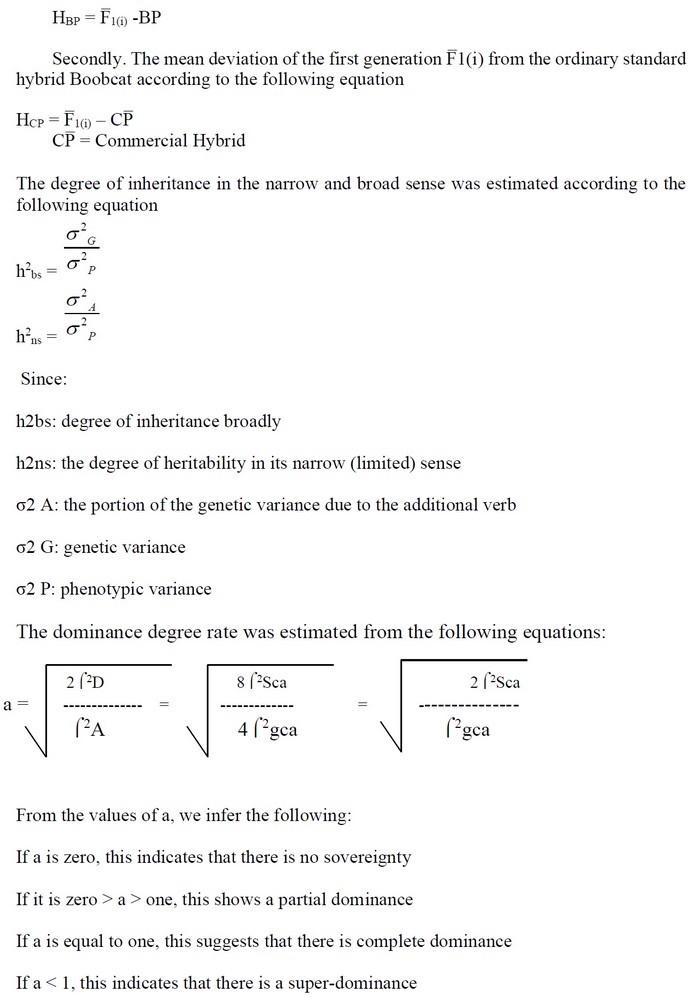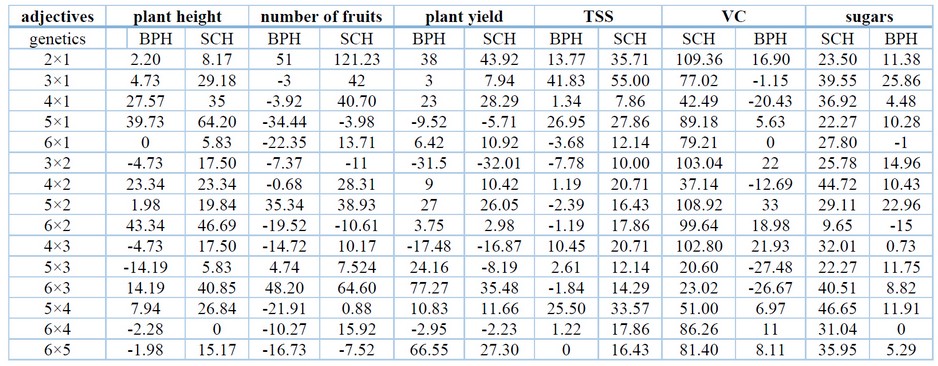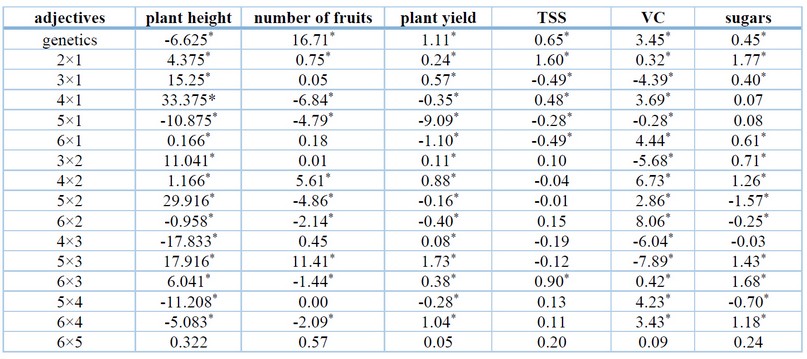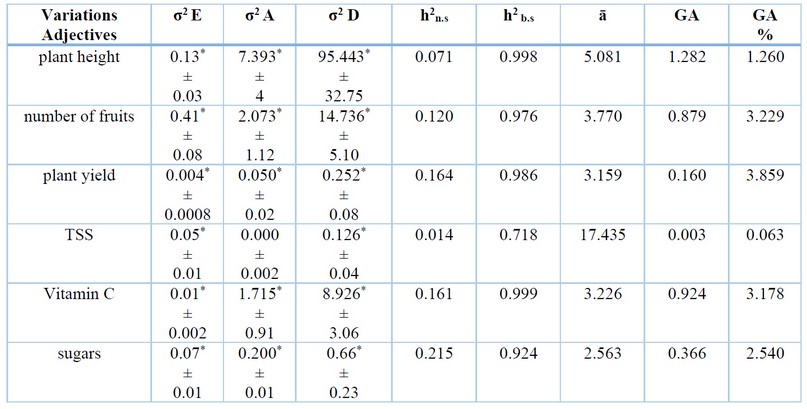2022.07.04.44
Files > Volume 7 > Vol 7 No 4 2022
Study of genetic analysis of individual hybrids derived by the half-diallel cross of some Lycopersicon esculantum mill
1Department of Horticulture and Landscape Gardening; College of Agriculture; University of Diyala; 32001, Baqubah; Iraq;
* Correspondence author: [email protected]
Available from: http://dx.doi.org/10.21931/RB/2022.07.04.44
ABSTRACT
The study was conducted for the first season of 2020 in the field of the College of Agriculture \ Diyala University which the seeds of the first generation F1 hybrids were produced for six strains that were selected according to the genetic distance among them and resulted in 15 hybrids by applying for the half diallel crossing program. In the second year, the seeds of individual hybrids were planted with their parents and a hybrid Commercial common boob cat for comparison within a field experiment to evaluate the field performance of these produced hybrids according to the design of complete randomized sectors and with three replications. The differences were tested according to the LSD test. The result showed that the highest hybrid strength compared with the highest parents for the trait of plant height 43.34 cm, number of fruits 48.20%, plant yield 77.27%, TSS ratio 41.83%, fruit content of vitamin C 33% and sugar content 25.86% for the above traits, respectively. As for the common commercial hybrid, Boob cat was 64.20%, 121.23%, 43.92%, 55%, 109.36% and 46.65%, respectively. As for the union ability, the father gave c.c. Orang (5) had the highest general combined ability for plant height which amounted to 3.972. For the number of fruits, plant yield and TSS, Father Rose (1) showed the highest general union ability, which amounted to 4.136, 0.358 and 0.095, respectively, while the vitamin C and sugars ratio were recorded by the fathers (5) Red P.t (2) and Amish Pa.(4). The highest general federating ability amounted to 1.937 and 0.975 respectively while the highest union ability for plant height in 1×5 hybrids reached 33.375 and for TSS and sugars the hybrid showed1×3The highest ability of a particular union was 1.60 and 1.77, respectively. Regarding the characteristics of fruit number and yield of a plant, the 1×2 hybrid was superior in a proportion of 16.71 and 1.11 for vitamin C, and the 3×4 hybrid was superior in a ratio of 8.06. As for the percentage of heritability was high compared to the strict sense, indicating the importance of non-host gene action of genes in the inheritance and manifestation of the trait. The mean of the degree of dominance was higher than one for all the mentioned traits, which evidences the participation of super dominance of genes in the manifestation of the trait.
Keywords: half-diallel, boob cat, genetic distance, Lycopersicon esculantum
INTRODUCTION
The tomato crop (Lycopersicon esculantum mill) family Solanaceae is one of the world's most essential and widespread vegetable crops because of its excellent nutritional value. The tomato contains calcium, iron, and vitamins A, B2, B6 and C. It also contains proteins, carbohydrates, amino acids and some pigments such as carotene. Lycopene and some phenolic compounds1. It grows in various environments, from dry regions to wet areas, as well as in different soils according to its original habitat. And genetic and even at the plant molecular level2. Because of the low production per unit area in the world and Iraq in particular, it has become imperative for plant breeders to search for means through which production can be increased and improved in quantity and quality, Which forms the basis of any crossbreeding program that aims to develop hybrid varieties as the genetic action of any trait is related to the amount of genetic variation and the ability to combine between the parental strains, and this is one of the necessary steps in developing and improving crops including the tomato crop. By testing them, the best genetically heterogeneous strains or varieties to obtain the phenomenon of hybrid vigor to produce hybrids that outperform the widely cultivated varieties in one or more traits3-5.
Cross-crossing is one of the most efficient breeding methods for selecting hybrids produced in the early stages or in later generations in breeding programs based on knowledge of the type of gene action that controls the inheritance of the trait6
This mating design has been standard in many plant species regardless of whether self-pollinating or cross-pollinating, as it satisfies the breeder's desire to obtain distinctive hybrids by identifying the best parents familiar with each other. There are three mating designs in breeding studies: the plant is the diallel, partial dialed, and line x tester.
The phenomenon of heterosis is one of the most critical agricultural phenomena that contributed to the development of agrarian production quantitatively and qualitatively. The phenomenon of hybrid vigor was first diagnosed by7,8. The first scientists who noticed the strength of the hybrid in tomatoes were Hedrick, and Booth9 was represented by an increase in yield and the number of fruits and then expanded to include yield components and qualitative characteristics10, and between Al-Shammari and Hamdi11 Showed that the genetic divergence between the parents is a helpful indicator of the performance of the crosses. Heterozygosity is more influential than homozygosity, and many studies have confirmed a positive association between the genetic divergence of parents and the high performance of the crosses11-14.
To derive individual hybrids of tomato by cross-crossing and evaluate them in comparison with one of the hybrids approved in the environmental conditions of the region and the possibility of adopting it locally and estimating the genetic parameters and the strength of the hybrid and then choosing the best hybrids produced in quantity and quality that are well cultivated under the environmental conditions of the region and the possibility of adopting it locally.
MATERIALS AND METHODS
First season: production of individual hybrids (F1)
The seeds of these strains were planted inside cork dishes in one of the nurseries located within the Khan Bani Saad district of Baquba Center on 13/1/2020. After the seeds germinated and the plants had reached the seedling stage, they were transferred and planted in the open field at the research station of the Department of Horticulture and Landscaping for the College of Agriculture, Diyala University within the first season on 10/3/2020, All crop service work was carried out including watering, irrigation, fertilizing and removing the grasses as needed for producing unique hybrids (F1).
During this season, half dialele was conducted among these six strains according to the first method and the fixed model of Griffing15 methods for the production of the first generation F1 hybrids, as shown in (Table 2) and resulted in 15 hybrids. The color of the flowers is cream. The bag was sacked after castration. The rest of the flowers were removed from the plant to ensure no cross-pollination.

Table 1. Some physical and chemical properties of field soil.

Table 2. Breeds used in crossbreeding and their source.

Table 3. Individual crosses are derived from pure strains according to the second Griffing method (1956).
Studied traits
The measurements were taken from a random sample of five plants in the experimental unit, and for each replicate, the average was taken. The studied traits included the following:
Plant height (cm): It was measured at the end of the growing season from the surface of the soil to the top of the plant for five plants within the experimental unit, and the average was taken.
The number of fruits per plant (fruit plant-1).
The number of fruits in the experimental unit was calculated cumulatively from the beginning of the harvest until the end of the growing season and divided by the number of plants in the experimental unit.
Plant yield (kg plant-1)
The cumulative yield was recorded from the beginning of harvest to the last pound for each experimental unit and then divided by the number of plants in one experimental unit.
The percentage of total dissolved solids (TSS %) was calculated using a Hand Refractometer.
The content of fruits of vitamin C (mg 100 g-1): It was estimated by smearing a specific volume of tomato juice with 2.6 Dichlorophenol indophenol dye and based on the mg unit of vitamin C per 100 g of fruit juice16.
Estimation of total sugars in juice (%)
It was estimated by taking 1 ml of diluted juice and adding to it 1 ml of 5% phenol solution (5 g of phenol in 100 ml of distilled water) and 5 ml of concentrated sulfuric acid with continuous shaking; then the light absorption was read by a spectrophotometer at a wavelength of 550 nm And to calculate the sugar content of fruits by dropping the readings on the standard curve prepared using glucose.
Statistical analysis
The standard statistical analysis was carried out according to the design of the entire random sectors with three replications, and data were entered (parents, single crosses, triple crosses and common commercial Bobcat crosses), and the averages were compared using the least significant difference (LSD) at the probability level of 5% and in the case of substantial differences between the treatments for the studied traits. The analysis is continued using the statistical method of this mating method by splitting the averages of the squares of the transactions into their components after collecting data for all the studied traits and populating using the Excel program; then, the data were statistically analyzed using the SAS program, and the data were compared according to the Tukey test at the probability level of 0.05, as the test was conducted regardless of the significance of F17.
Hybrid vigor of individual hybrids was estimated based on
Firstly: The mean deviation of the first generation F̅1(i) from the best parents BP according to the following equation:

RESULTS AND DISCUSSION
The results of Table 4 show the strength of the hybrid based on the best parents and the standard hybrid for the studied traits. Most hybrids showed positive and positive hybrid vigor in the desired direction for the plant height trait. The highest was the hybrid 2×6 which scored 43.34 compared with the best parents. Compared with the commercial hybrid, the hybrid 1×5 showed the highest desirable hybrid vigor of 64.20% for the number of fruits. The hybrid 3×6 showed the highest rate of 48.20% compared with the highest parent, while the hybrid 1×2 recorded the highest hybrid strength compared with the standard hybrid, which amounted to 121.23%. It reached 77.27%, while the hybrid 1×2 recorded the highest significant and desirable hybrid strength compared with the standard hybrid, which amounted to 43.92%. As for TSS, the hybrid 1×3 showed positive and significant hybrid strength compared with the best parents, with a percentage of 41.83% compared to the commercial hybrid. The above hybrid had the highest hybrid strength of 55%. The highest hybrid strength distinguished the 2×5 hybrid compared to the best parents for vitamin C, which amounted to 33%. The hybrid 1×2 showed the highest significant and positive hybrid strength of 109.36% compared with the standard hybrid. As for sugars, the hybrid 1×3 was distinguished by the best hybrid strength compared to the highest hybrid, which amounted to 25.86%, while the hybrid 4×5 recorded the highest hybrid strength compared with the commercial hybrid 46.65%. The difference of hybrids in the above traits is mainly due to the variation of their genetic composition, which in turn affects the physiological ability and its efficiency in converting the products of photosynthesis in favor of the growth and elongation of stem cells and then the increase in plant height and number of branches which is reflected on other vegetative growth indicators. In other words, the trait Vegetativeness is mainly determined by genetic factors and shares with them the response of hybrids to the influence of environmental factors affecting their growth, including agricultural service operations5,14,18,19.

Table 4. Shows the strength of the hybrid (%) based on the deviation of the first generation from the highest parent and the commercial hybrid (Bobcat).
As shown in Table (5) the results of the statistical genetic analysis and the splitting of the mean squares of the genotypes into components that belong to the general and specific abilities of the union according to the second method of the first model (Fixed Model) proposed by Griffing (1956).
The analysis of variance of the genotypes data (parents + individual hybrids + common commercial Bobcat hybrid) for all traits shows that the mean of squares was significant for all the traits that were under study. The general ability to combine was highly significant for most traits except for TSS, which did not reach the significance limit as the results presented in Table 5 showed a highly effective effect of the mean squares of genotypes and their interactions for all studied traits and identifying the nature of the work of the genes that control the inheritance of the studied traits. These results are consistent with what was found by a group of researchers including14,20-22.

Table 5. results of the analysis of variance for the genotypes (parents + individual hybrids + common commercial Bobcat hybrid), fathers and individual crosses for the studied traits.
Table (6) shows the effect of the general ability to combine for all the traits under study that were estimated and their results are shown in the above table in which it is noted that Father 1 showed a general desirable and significant ability to combine for the characteristic of plant height, number of fruits, yield of one plant, TSS and vitamin C,. As for Father 2. It showed a desirable and moral effect of the general ability for the characteristics of the number of fruits, plant yield, TSS and vitamin C to combine, while Father 3 showed a broad ability of positive and significant for the trait of plant height and TSS to combine and father 4 showed a general effect on the combination significantly and in the desired direction for the trait of the yield of the plant only and the percentage of sugars. Father 5 was characterized by a general ability of significance and the desired direction for the characteristic of plant height only to combine. At the same time, father 6 showed a generally desirable and important combining ability for vitamin C traits.

Table 6. Estimating the effect of the general ability of the parents to combine on the indicators of vegetative growth, flowering and yield of tomato plants.
Table (7) shows the effect of the special ability on the union of individual hybrids for all the studied traits, and it is noted that the plants shown by the parents due to the variation in the general ability to combine have an effect on the behavior of the resulting hybrids through the crossing tip between them. The height of the plant 9 crosses showed the power to destroy, especially for the significant and positive union. The highest reached 33.37 for the hybrid 1×5. For the number of fruits, 4 of the hybrids achieved a positive and significant unique ability to destroy the difference in the special ability to combine, reached a maximum of 16.71 for the hybrid 1×2, and 9 genotypes for the trait of the plant yield showed a special ability to combine positive and significant in the direction.
The desired one was the best of the hybrid 3×6 scoring 1.73 while 4 crosses were distinguished for TSS and showed positive and desirable values that hare special ability to combine. The maximum was the hybrid 1×3, scoring 1.60.
As for the content of the fruits of vitamin C, 10 crosses showed the highest positive and significant special to combine ability in the desirable direction. The highest hybrid was 3×4, which scored 8.06. For the percentage of sugars, 9 combinations were distinguished. They gave positive, significant and desirable values for the unique ability to combine, which reached the highest rate in the 1×3 hybrid, which scored 1.77.

Table 7. Estimates of the effects of special ability on the union of individual crosses for all studied traits.

Table 8. Estimates of the components of phenotypic variance, standard error, heritability, mean degree of dominance, and expected genetic improvement for the studied traits.
Table (8) shows the components of the phenotypic variance for the traits studied, and we note that the environmental conflict differed from zero for all the traits studied. In contrast, the additional genetic variance differed from zero for the characteristics under study except for the TSS percentage while the sovereign genetic variance differed from zero.
For all studied traits, the values of dominance genetic variance were greater than those of additional genetic variance. The table above shows that the importance of gene variance is greater than the environmental variance values for all the studied traits except for TSS. Accordingly, these traits can be genetically improved. These results agree with what was found by14,23,24 in their studies on tomato plants. Shown in the table (8) are the values of heritability, the rate of the degree of dominance and the expected genetic improvement of the traits studied; it is noted that the importance of heritability in the broad sense was high and close in all the traits studied, while the values of heritability in the narrow mind for all the traits studied for TSS were low.
CONCLUSION
The low values heritability in the narrow sense has appeared in the characteristics of plant height. TSS this decrease is due to the decline in the value of additional genetic variance and the increase in the value of the dominant genetic variance. As for the average degree of dominance, it was more significant than one for all the traits under study, which indicates the presence of super-dominance at some genetic sites that control the inheritance of all the traits studied. These results are consistent with what was found25.
REFERENCES
1. Al-Shammari AMA, Hamdi GJ, Genetic diversity analysis and DNA fingerprinting of tomato breeding lines using SSR markers. Agraarteadus 2021; 32(1):1–7. DOI: 10.15159/jas.21.13
2. Al-Shammari, AMA, Abood MA, Hamdi, GJ. Effect of addition perlite to soil in reducing water stress and its effect in some characteristics of the yield of three genotypes of tomato. Journal of Agricultural, Environmental and Veterinary Sciences 2017; 2(1)-1-13. DOI: 10.26389/AJSRP.J120617
3. Al-Shammari, AMA, Abood MA, Hamdi, GJ. Perlite Affects Some Plant Indicators and Reduces Water Deficit in Tomato, International Journal of Vegetable Science 2018; 24:5, 490-500, DOI: 10.1080/19315260.2018.1439853
4. Barbosa AMM, Geraldi IO, Benchimol LL, Garcia AAF, Souza CL, Souza AP. Relationship of intra and inter population tropical maize single cross hybrid performance and genetic distances computed from AFLP and SSR markers. Euphytica 2003; 130: 87-99.
5. Belew J, Belew D, Bantte K. Genetic association analysis among some traits of tomato (Lycopersicon esculentum Mill.) genotypes in West Showa. Ethiopia International Journal of Plant Breeding and Genetics 2012; 6: 129–139. DOI 10.3923/ijpbg.2012.129.139
6. Chaudhary B, Punia RS, Sangha HS. Manifestation of hybrid vigour in F1 and its correlation in F2 generation of tomato Lycopersicon esculentum Mill. Indian J. Hort 1965; 22:52-59.
7. Dean A, Voss D, Draguljić D. Split-Plot Designs. In: Design and Analysis of Experiments. Springer Texts in Statistics. Springer, Cham 2017; DOI: 10.1007/978-3-319-52250-0_19
8. Dharva PB, Patel AI, Vashi JM, Chaudhari BN. Combining ability analysis for yield and yield attributing traits in tomato (Solanum lycopersicum L.). International Journal of Chemical Studies 2018; 6(3):2342-2348.
9. East EM. Studies on flower size inheritance in Nicotiana. Genetics 1916; 1:164-176.
10. Erika C, Griebel S, Naumann M, Pawelzik E. Biodiversity in tomatoes: Is it reflected in nutrient density and nutritional yields under organic outdoor production? Frontiers in Plant Science 2020; 11: 589692. DOI:10.3389/fpls.2020.589692
11. Griffing B. Concept of general and specific combining ability in relation to diallel crossing systems. Australian Journal of Biological Sciences 1956; 9(4):463-493. https://doi.org/10.1071/BI9560463
12. Hamdi GJ. Effect of perlite in reducing water stress for three genotypes of tomato. MS Thesis, College of Agriculture, University of Diyala, Diyala, Iraq 2017; pp.135.
13. Hamdi GJ. Estimate the genetic distance and genetic parameters of growth characteristics and yield of tomato using half diallel cross under water stress. PhD. Thesis. College of Agriculture. University of Diyala. Iraq, 2022; 218 p.
14. Hallaure ; W.A. Russell ; and K.R. Lamkey . 1988. Corn and corn improvement : corn breeding.
15. Hedrick UP, Booth NO. Mendelian characters in tomato, Proc. Am. Soc. Nort. Sci 1908; 5:19-24.
16. Islam S, Hassan L, Hossain MA. Breeding potential of some exotic tomato lines: a combined study of morphological variability, genetic divergence, and association of traits. Phyton-International Journal of Experimental Botany. 2022; 91(1):97–114. DOI: 10.32604/phyton.2022.017251
17. Kande D, Bedre R, Mandadi K, Crosby K, Avila C. Genetic diversity and population structure of tomato (Solanum lycopersicum) germplasm developed by texas A&M breeding programs. American Journal of Plant Sciences. 2019; 10:1154-1180. DOI: 10.4236/ajps.2019.107083
18. Kapur A, Hasković A, Copra-Janićijević A, Klepo L, Topčagić A., Tahirović I, Sofić E. Spectrophotometric analysis of total ascorbic acid content in various fruits and vegetables. Bulletin of the Chemists and Technologists of Bosnia and Herzegovina 2012; 38: 39-42.
19. Kerketta,A. Genetic study of heterosis for yield, fruit quality and leaf curl resistance in tomato (Solanum lycopersicum L.) genotypes. Thesis, Ph.D. Sam Higginbottom University of Agriculture, Technology and Sciences. Prayagraj. Indian 2020.
20. Kherwa RS. Heterosis for fruit yield and quality traits of tomato (Solanum lycopersicum L.). Thesis. M.Sc. Bihar Agricultural University, Sabour. India 2017.
21. Kulus D. Genetic diversity for breeding tomato. In: Priyadarshan P., Jain S.M. (eds) Cash Crops. Springer, Cham 2022; DOI: 10.1007/978-3-030-74926-2_13
22. Kumar C. Heterosis and combining ability studies in diallel crosses of tomato (Solanum lycopersicum L.). Thesis, M.Sc. Banaras Hindu University, India. 2015; pp 168.
23. Liu XC, Ishiki K, Wang WX. Identification of AFLP markers favorable to heterosis in hybrid rice. Breed Sci 2002; 52:201-206.
24. Mowfak F.M. 2014. Effect of fertilizer type on growth characteristics and yield of tomato and the estimation of some genetic parameters. Master Thesis. Department of Horticulture and Garden Engineering. faculty of Agriculture. PhD thesis. faculty of Agriculture. Diyala University. p. 52.
25. Sabry MK, Rakha SA. Heterosis, nature of gene action for yield and its components in tomato (Lycopersicon esculentum Mill.). Middle East J 2019; 8(4):1040-1053.
26. Shull GH. Hybridization methods in corn breeding. Am. Breeders mag 1910; 1:98-107. AR Hallaure, WA Russell, and KR Lamkey. 1988. Corn and corn improvement. corn breeding.
Received: August 25, 2022 / Accepted: October 12, 2022 / Published:15 November 2022
Citation: Al-Shammari A M A, Al- Obaiday A R H. Study of genetic analysis of individual hybrids derived by the half-diallel cross of some Lycopersicon esculantum mill. Revis Bionat a 2022;7(4) 44. http://dx.doi.org/10.21931/RB/2022.07.04.44
